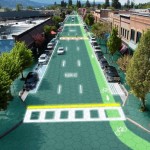 Idaho couple Julie and Scott Brusaw of Solar Roadways have raised more than $1 million on Indiegogo to pursue the extremely ambitious goal of replacing the nation’s roads with solar panels. The design will now move from prototype to manufacturing, a dangerous phase for any technology project – and while the dream is exciting, the logistics of actually pulling it off are less so.
Idaho couple Julie and Scott Brusaw of Solar Roadways have raised more than $1 million on Indiegogo to pursue the extremely ambitious goal of replacing the nation’s roads with solar panels. The design will now move from prototype to manufacturing, a dangerous phase for any technology project – and while the dream is exciting, the logistics of actually pulling it off are less so.
The Brusaws are not scammers or wackos. Scott has an electrical engineering background and the project has gotten two rounds of funding from the Federal Highway Administration. They’ve built a prototype parking lot made of solar panels, microprocessors, and LEDs encased in a textured glass that they say can withstand the weight of a 250,000-lb. truck.
In theory, the idea could work: replace all the nation’s asphalt with solar panels, and we’d generate more than three times the electricity the US uses. Solar Roadways’ design would also filter stormwater, replace above-ground power cables, prevent icy roads by melting snow, and light up to warn drivers if a moose wanders onto the road.
Unfortunately, the list of obstacles is long. The main problem is cost. “Sure, we could pave the streets with solar panels, but we could also pave them with gold,” science writer Aaron Saenz wrote in 2010, when Solar Roadways was first getting national attention. “There is roughly 29,000 square miles of road surface to cover. We need roughly 5.6 billion panels to cover that area. That’s a price tag of $56 trillion!”
Even using the Brusaws’ rosy numbers, which Saenz says overestimate the cost of asphalt, he writes solar roads are 50 percent more expensive than traditional roads.
The Indiegogo campaign does not address the cost issue, and the Brusaws are vague about what exactly the $1 million will buy. “We need to make a few tweaks to our product and streamline our manufacturing process so that we can make our panels available to the public as quickly as possible,” they write.
Joel Anderson, a business editor for Equities.com, was one of the few in the media to throw cold water on the idea. “The Brusaws have been unable to secure any piece of the more-than $2 billion a year spent on solar research and development around the world,” he writes. “Probably because there’s too many more-practical, more-promising investments to be made to seriously consider this pipe dream.”
Read more at THE VERGE.
{Matzav.com Newscenter}











